Abstract
Aim
The aim of this study was to examine the arterial vascularization of the appendix, in order to propose a classification of the different vascular types of the appendix for the realization of free transfer in reconstructive microsurgery.
Materials and methods
We achieved the removal as a monobloc of the cecum, of a part of the ileum, and the upper colon, then conducted the intra-arterial injection of a mixture composed of minium, and went on to the dissection of 25 specimens of appendix from West Africa. We analyzed the appendicular territory vascularized by the different discovered arteries.
Results
The average length of the appendix was 10.5 cm, ranging from 6.5 to 13.5 cm. The vascularization of the appendix was guaranteed by three arteries: the main appendicular artery, the ceco-appendicular artery and by one or several appendicular accessory arteries. We found five types of vascularization of the appendix according to the number and type of artery needed to guarantee the vascularization of the whole of the appendix including its base.
Conclusion
It is evident from this study that a detailed analysis of the vascularization of the appendix is necessary before its removal for a reconstructive microsurgery, because in three cases out of four, the transplant must include at least two vessels in order to guarantee the whole of its vascularization.











Similar content being viewed by others
References
Ajmani ML, Ajmani K (1983) The position, lengh and arterial supply of vermiform appendix. Anat Anz 153:369–374
Broelsch CE, Whitington PF0, Emond JC, et al (1991) Liver transplantation in children from living-related donors. Ann Surg 214:428
Bales GT, Kuznetsov DD, Kim Hyung L, Gottlied LJ (2002) Urethral substitution using an intestinal free flap: a novel approach. J Urol 168:182–184
Couinaud A (1963) L’évolution embryologique du péritoine et du tube digestif abdominal. In: Anatomie de l’abdomen (petit bassin excepté). Edition Doin, Paris, pp 155–169
Gillot C (1966) L’abdomen et son contenu viscéral. In: Anatomie tronc et membres. Edition Flammarion, Paris, pp 628–648
Goldwasser B, Leibovitch I, Avigad I (1994) Ureteral substitution using isolated interposed vermiform appendix in patient with a single kidney and transitional cell carcinoma of ureter. Urology 44:437–440
Juma S, Nickel JC (1990) Appendix interposition of the ureter. J Urol 144:133
Komatz Y, Itoh H (1990) A case of urethral injury repaired with appendix. J Urol 144:132
Koshima I, Inagawa K, Okuyama N, Moriguchi T (1999) Free vascularized appendix transfer for reconstruction of penile urethras with severe fibrosis. Plast Reconstr Surg 103:964–969
Lloyd SN, Kenedy C (1989) Autotransplantation of the vermiform appendix following ureteroscopic damage to the right ureter. Br J Urol 63:216
Marrie A (1991) Chirurgie de l’appendice iléo-caecal. In: Traité de techniques chirurgicales-appareil digestif: 40–500. Elsevier, Paris
Martin LW (1981) Use of the appendix to replace a ureter. Case report. J Pediatr Surg 16:799–800
Mitrofanoff P (1980) Cystostomie continente trans appendiculaire dans le traitement des vessies neurologiques. Chir Pediatr 21:297–305
Mazzaferro V, Esquivel CO, Makowa L, et al (1989) Hepatic artery thrombosis after pediatric liver transplantation. A medical or surgical event? Transplantation 47:971
Shah MA, Shah M (1946) The arterial supply of the vermiform appendix. Anat Rec 95:457–460
Solanke TF (1968) The blood supply of the vermiform appendix in nigerians. J Anat 102:353–361
Solanke TF (1970) The position, lengh, and content of the vermiform appendix in nigerians. Br J Surg 57:100–102
Valla JS (1988) Hepaticoportoappendicostomy. J Pediatr Surg 23:1057–1058
Vandamme JP, Bonte J (1982) A new look at the blood supply of the ileocolic angle. Acta Anat (Basel) 113:1–14
Weinberg RW (1976) Appendix ureteroplasty. Br J Urol 48:234
Whoodhouse CR, Malone PR, Cumming J, Reilly TM (1989) The Mitofanoff principle for continent urinary diversion. Br J Urol 63:53–57
Author information
Authors and Affiliations
Corresponding author
Rights and permissions
About this article
Cite this article
Ouattara, D., Kipré, Y.Z., Broalet, E. et al. Classification of the terminal arterial vascularization of the appendix with a view to its use in reconstructive microsurgery. Surg Radiol Anat 29, 635–641 (2007). https://doi.org/10.1007/s00276-007-0265-6
Received:
Accepted:
Published:
Issue Date:
DOI: https://doi.org/10.1007/s00276-007-0265-6




